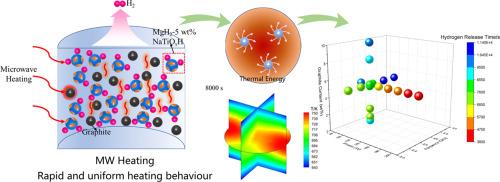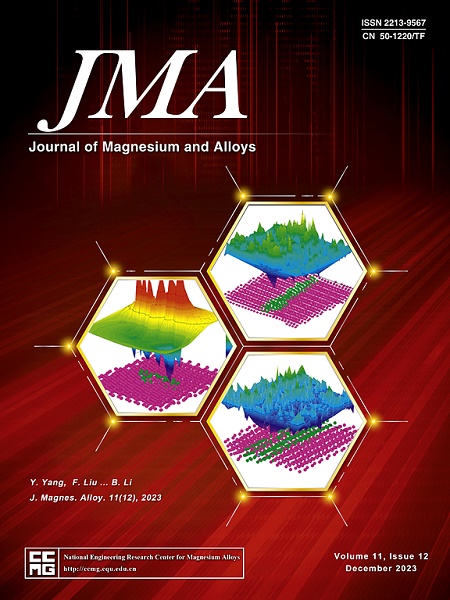Low-energy and accelerated hydrogen release from MgH2–5 wt% NaTiOxH catalyzed hydrogen storage reactor by graphite responsive microwave
IF 13.8
1区 材料科学
Q1 METALLURGY & METALLURGICAL ENGINEERING
引用次数: 0
Abstract
Owing to high thermal stability and large reaction enthalpy, MgH2 has high reaction temperatures and sluggish reaction kinetics in the dehydrogenation process, which consumes lots of energy. To achieve hydrogen release with low energy consumption, accelerated reaction rate, and high heating uniformity, this paper proposes a novel method of graphite responsive microwave-assisted thermal management with NaTiOxH catalyst. A multi-physics model of the 5 wt% NaTiOxH catalyzed MgH2 reactor integrated with a microwave generator is developed to investigate the reaction, heat and mass transfer process of hydrogen release. It is found that the graphite responsive microwave heating method could improve the temperature uniformity of reaction bed, reduce the energy consumption by at least 10.71% and save the hydrogen release time by 53.49% compared with the traditional electric heating method. Moreover, the hydrogen desorption thermodynamics could be improved with the increase of microwave power. The hydrogen release time is shortened by 19.55% with the increase of 20 W microwave power. Meanwhile, it is also concluded that the microwave excitation frequency of 2.1 GHz and the graphite content of 2 wt% have better heating performance. Therefore, it can be verified that the graphite responsive microwave heating helps to low-energy and accelerated hydrogen release from MgH2 hydrogen storage reactor.


石墨响应微波在MgH2-5 wt% NaTiOxH催化储氢反应器中低能加速释氢
由于热稳定性高,反应焓大,MgH2在脱氢过程中反应温度高,反应动力学缓慢,消耗大量能量。为了实现低能耗、加速反应速率和高加热均匀性的氢气释放,本文提出了一种基于NaTiOxH催化剂的石墨响应微波辅助热管理新方法。建立了含微波发生器的5wt % naatioxh催化MgH2反应器的多物理场模型,研究了氢气释放的反应、传热和传质过程。研究发现,石墨响应微波加热方法与传统电加热方法相比,可提高反应床温度均匀性,降低能耗至少10.71%,节约氢气释放时间53.49%。此外,随着微波功率的增加,氢的解吸热力学可以得到改善。随着微波功率的增加,氢的释放时间缩短了19.55%。同时,还得出了微波激励频率为2.1 GHz、石墨含量为2 wt%时具有较好的加热性能的结论。因此,可以验证石墨响应微波加热有助于MgH2储氢反应器的低能量和加速氢释放。
本文章由计算机程序翻译,如有差异,请以英文原文为准。
求助全文
约1分钟内获得全文
求助全文
来源期刊

Journal of Magnesium and Alloys
Engineering-Mechanics of Materials
CiteScore
20.20
自引率
14.80%
发文量
52
审稿时长
59 days
期刊介绍:
The Journal of Magnesium and Alloys serves as a global platform for both theoretical and experimental studies in magnesium science and engineering. It welcomes submissions investigating various scientific and engineering factors impacting the metallurgy, processing, microstructure, properties, and applications of magnesium and alloys. The journal covers all aspects of magnesium and alloy research, including raw materials, alloy casting, extrusion and deformation, corrosion and surface treatment, joining and machining, simulation and modeling, microstructure evolution and mechanical properties, new alloy development, magnesium-based composites, bio-materials and energy materials, applications, and recycling.
 求助内容:
求助内容: 应助结果提醒方式:
应助结果提醒方式:


